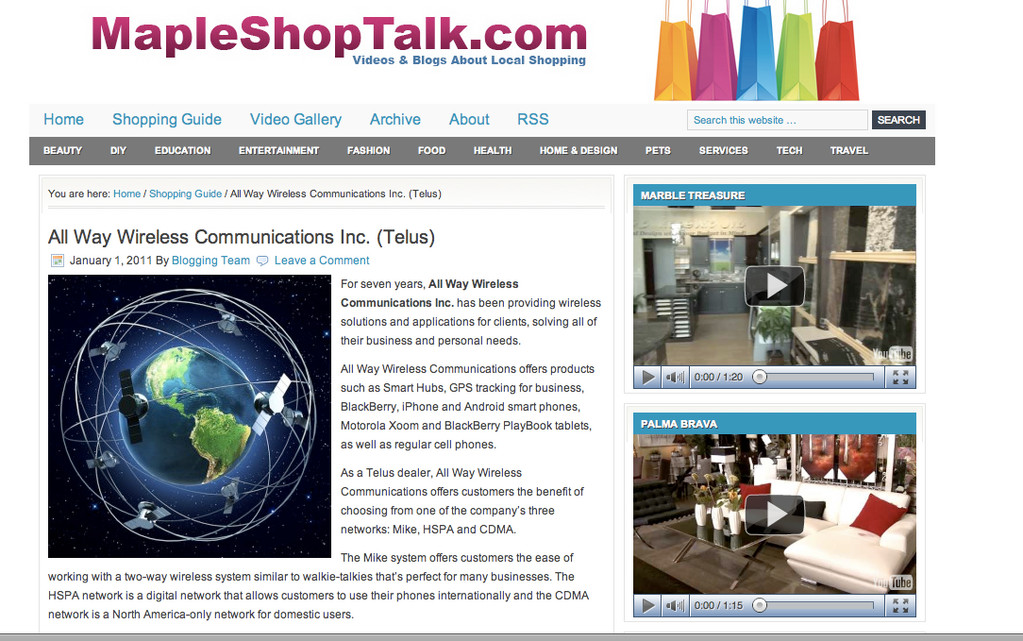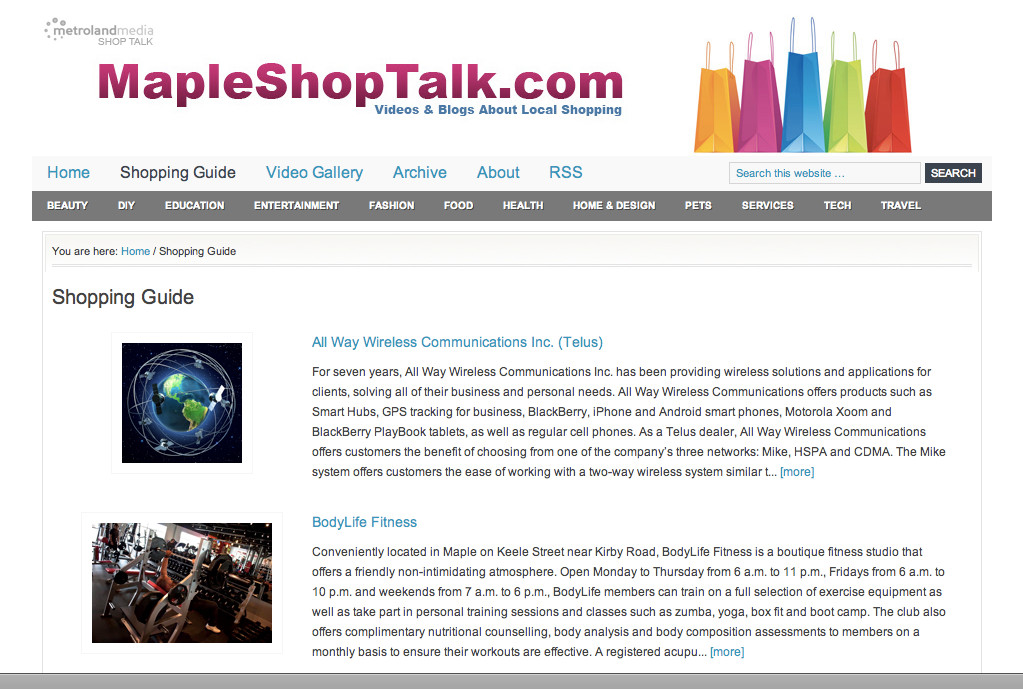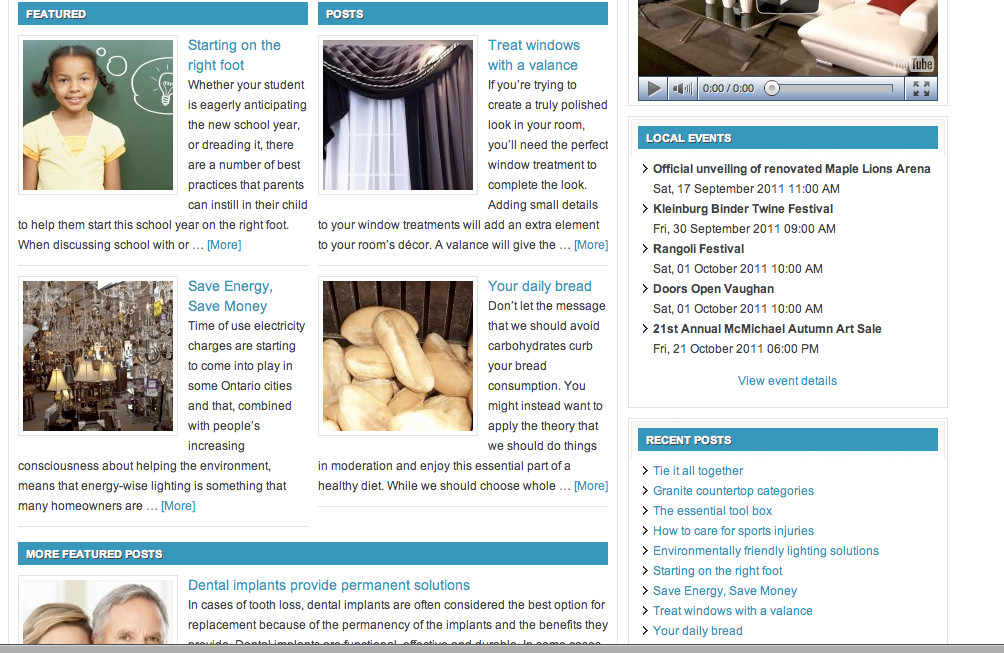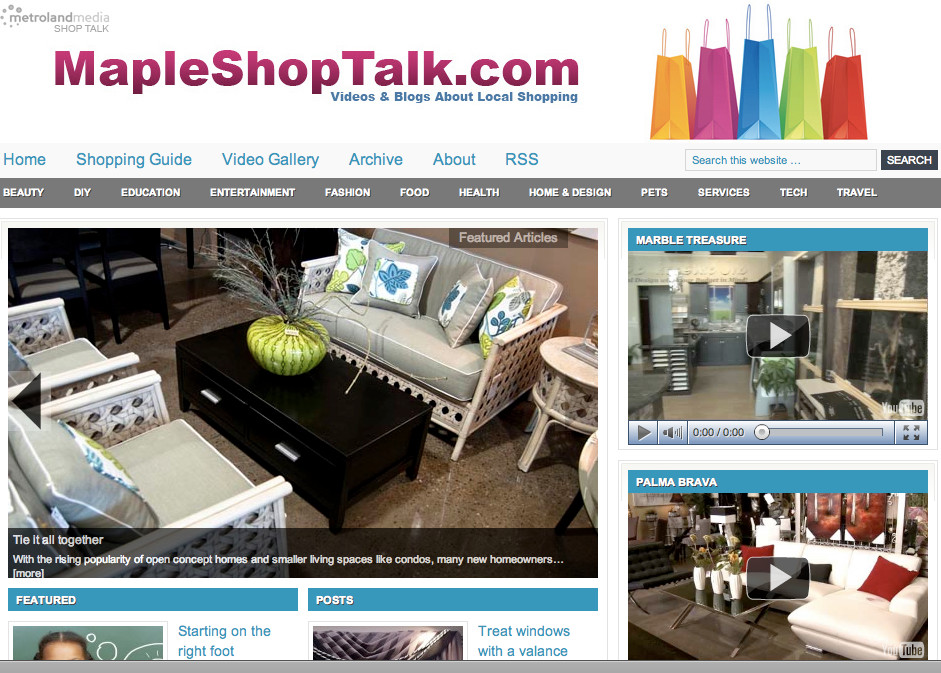The Mother-of-all-bundles? Metroland's video, blog, micro-site, print, QR Code package
A unique bundle generates a cool $1 million in new annual sales across ten sites in just three months
Initiative: The video/blog/QR code/ShopTalk bundle
Key Executive: Meriel Bradley, Director of The Digital Video Group
Company: Metroland Media, owner of 109 community newspapers in Ontario, Canada
First Market: 10 newspapers in the York Region
Summary: Bundling video, blogging, and print with QR codes is paying off as the most successful program for Metroland in decades. In fact, the program generated $1 million in annual sales in the first three months, of its launch by ten community newspapers in York, Ontario in Canada. The program plans to have $8 million in new sales across its 100 plus newspaper sites by the end of the year. None of the individual components is actually new, however, the way they are integrated as a package, is. And it sells. Below is a full break-down of how the program works. Please note: This company was part of Suburban Newspaper Association's Innovation Mission.
Challenge: Two thirds of online advertising by local merchants is spent on infrastructure (web sites) and promotions. So Metroland tasked its digital media group to come up with a new bundled package that addressed what merchants were buying in the market. To meet key criteria, the new bundle needed to:
*Integrate print with non-traditional product that appeal to emerging marketing needs of small businesses, ie appear to serve a variety of important needs at once
*Turn sporatic advertisers into annual contracts
*Take advantage of the Digital Video Groups production assets
*Be easy for merchants to understand and reps to sell.
Bradley, who’s background incutes 20 years in television on and off the air was instrumental in setting up the workflow, although it could be outsourced.
Strategy: For proof of concept, the new sales product, that included A ShopTalk site built on WordPress, would be rolled out first to the York regional group, with ten newspapers in a number of small communities. The 12 month bundle combines a number of elements:
a. A sixty second video
b. 12 blogs, as a service
Both the videos and blogs are featured as content on the home page of ShopTalk microsites, that roll into the newspaper sites.
c. A full merchant profile, in ShopTalks "Shopping Guide" directory, aggregates all of the merchant information plus the video and blogs.
d. 12 prints with QR code, that scans to a mobile version of the merchant profile.
In addition, extra features include Twitter and Facebook posts.
Here is how the program was put together, component by component, followed by how the process works, when put together, and results:
1. Video – A key component of the package is a production of the 60 second video, styled as a merchant interview/feature, which resides on the a new ShopTalk website and as a landing page for print QR codes. The video feature also serves as a permanent asset for the merchant and for the media company - that is the video is also automatically posted to YouTube and the merchant can use it for its own website, other directories or Facebook.
As Bradley says: "Video is critical marketing tool for every single business. If you create a video for a business they can utiliize it in many ways."
A variety of "compelling statistics" help sell video, including these:
*90% of online consumers say attaching video inflences their buying decision.”
*Web sites with video are 53% more likely to show up on page one of Google then web sites without video.
*Comscore Canada also shows 52% of online video audience is older than the age of 25 (note the QR code audience is considerably younger – 54% under 35 years old in the U.S.)
(Metroland already had a full time videography group, however you can copy some of these elements by working with an outsourced videographers and Affinity, which supplies offsite editing for LMI members at JRC see sources at the end of this report).
Here are keys to shooting the segments:
*Using the live television method for conducting interviews
Bradley took “live television method and appied it in the field.” (JRC and television stations have also used this interview method with small merchants). Videographers have a script and a shot list. Rather than a commercial directed by the merchant's advertsing message, the videographer creates a feature that looks more like content. The actual videos are transparently promotional, set behind canned music, and also have their own site, so there is really no confusion with editorial content.
*The merchant is inteviewed in advance to establish some questions and get prepared. Key questions are likely to be “questions they get asked day in day out, and main points.” A few merchants don't want to be on camera, go with a voiceover, but most agree and the videographer can decide afterword if it's strong enough to carry a sixty second spot, or will be supplemented with a voiceover. The shot list includes the store front, a shot of the interior, or a cook making a recipe.
*The spots have the advantage of being evergreen. "We want evergreen content, instead of a used car sales person screaming 'come on down.' The content (look and fee) is better. Merchants (interviewed about their businesses) are passionate about what they do.”
Even with a streamlined process, it takes six hours of manpower to produce 60 seconds from soup to nuts. The work schedule is tight: A half an hour on the phone to plan the shoot, a couple of hours shooting. “They don’t have time for you to take over their business for the day, we are in and we’re out.” Then about three hours in editing and proofing, which is also done inhouse.
The Phase 1 roll-out - ie beyond York to the other 15 or so regions with 109 community newspapers - will eventually producing 1200 videos, " so we better be efficient." Bradley advices maintaining "client control" - ie not accomodating requests for shoots at multiple locations or other special needs, to stay on schedule. (Additional production could be part of Phase 3 or 4, combined with an ad agency-style business unit).
2. Blogs
Metroland also provides 12 blog posts, once a month, which sides on the ShopTalk web site. Each Shoptalk community site has just 15 merchants, so with ten newspapers in York, that's 150 merchants, and 150 blogs monthly, just in one region. The limits help the sites sell out, and get reps motivated to "get their share" fo the opportunity (Bradley reports that some sales reps were on the phone to clients selling during the breaks in her roll-out presentation).
“Blogging is an amazing way (for merchants) to start working on SEO. Businesses know they need to do it but they don't know how to do it.” Metroland has a built up a stable of 22 freelance writers, who will be fully utilized as more regions roll out. “In Phase one – that phase that aims at 1200 new customers) we will be writing 15,000 blog posts between May when we started and may year.”
Benefits of blogs to merchants are susbstantial. A key selling stat here is this one: Web sites that have blogs have 55% more web traffic, because the blogs are contestently refreshing, something Google likes. Bradley says she explains the process to clients, “just like you refresh your store front.”
Every site has a twitter account, tweeting the posts, and post to Facebook.
Streamling blog production
To make blogging efficient, all of the interviews are conducted on the phone, and written in blocks, three times a year. The first inteview is used to create the first four posts and the product page. Planning allows us “to seasonalize the posts and maker sure we are not rewriting things.”
Rather than a rote group of questions, bloggers like videographers look for "questions merchants get asked day in and day out." A furniture store might be asked about trends of the season, colors, lamp shades on tables. This approach “ Puts them into the shoes of being the expert, giving that credibility and third part endorsement.
Since trends in types of merchants are developing, she sees bloggers specializing in verticals, such as automotive, who can right for multiple markets as the most efficient way to create blogs in the future.
Pay for bloggers is just $35 a post. But four posts can be written from a half hour interview. And with 15,000 posts available “ between now and the end of the year, "you can write as many as you want."3. Merchant profile pages
Assets such as the merchant contact information, a brief description, the videos and blogs are aggregated on teh merchant's profile page, which resides in the "Shopping Guide," behind a button on the ShopTalk home page nav bar. The rest of the home page is composed of latest or featured videos (top half) and blogs (bottom half) which do not have the full merchant logo and address, but do include the name and phone number. To see how the pages navigate go to Mapleshoptalk.com or click through the images to the right (and click to enlarge).
4. Print
The print component includes twelve ¼ page ads that run on group pages once a month in the newspaper associated with the Shoptalk site. Each ad has a QR code (see do’s and don’t of QR codes here). The execution here is fairly straight forward, since newspapers simply generate and ad a code to the print materials. However, Bradly recommends a few best practices:
a. Test the QR Code once, before giving it to the client
b. Use a url shortener, unique to the client and the code. The shortener allows the URL to change, if a new video goes up.
c.Choose a QR Code provider who offers reporting
d. The QR code company needs to be stable and have adequate server backup system- you don’t want to lose , say, 1200 codes supporting millions in ad revenue - if the QR code server goes down.
Selling the new bundles
After combining the video, print, websites, and blogs, whole package looks like this:
*12 quarter page print ads
*12 months of hosted blogging
*60 second video with co-own right
*Still images shot at the same time
*QR code licence for 12 months
*A product page with the video.
*12 blog posts written by professional writers
*Posting of the video to YOUTube
*Building SEO key words into blogs, profile
The Digital Video Group has seven sales staff specialized in video, and who are available to support print sales reps after the initial roll-out presentation. A publisher can use as much or as little support from the video sales team as they want.
"We don’t tell the publishers how to do it, just that we are there as the support team. If they want to go out and sell it on their own, they can."
In York, the sales process was the easiest part; of 150 new sales, 30% were brand new clients. Video proved to be a great "door opener" and another advantage is that " the program can use advertising dollars as well as and marketing dollars. "It's not designed to take from one pot and put it into another."
The monthly spend depends on the print run of the newspaper, and the allocation is determined with the publisher. In general, the full page rage divided by four, or around $300 to $700 a month.
Metroland did not require exclusitivity by category, but focused on acquiring different kinds of businesses for the 15 spots on each site. “We do not want to go out and get three pet stores and two hair dressers."
Limiting inventory also helped close and manage the production process, “in a controled manner, which we could not have done if we let the whole sales team loose.”
Putting it all together: The Production process
Because there are so many moving parts, the entire workflow has to be diagramed and scheduled. Here is the order:
1. Make the sale
2. Process contact,
3. Assign writer,
4. Assign QR CODE,
5. Book the shoot
6. Send content for approval
7. Upload to site
8. Start print campaign
An assignment manager assigsn blogs, production coordinator handles the video and books the shoot, which goes to the scheduler for the videographer. Edited video and blogs go to content coordinators for posting. Once sites are posted, the print starts. The ads run on the same day each in that paper as part of a four page group of ShopTalk advertisers. .
Built on Word Press, the content management team only takes minutes to upload a post and tag it. “Workflow has to be simple and easy."
Once the sales are made, it takes six weeks for the site - and each individual order - to be completed. A huge amount of the time - about a week - is spent finding the client to schedule the video. Bradley recommends keeping the work pathway tight by not attempting to acommodate additional client requests. Those can be built into Phase 3 and 4, but only create chaos when launching a complex program.
Results
1. Bundles are selling out. As of September 10, ten sites had launched with another 12 sites underway in the next 30 days. "Between now and next year we will have 80 sties going. What nice is that in phase one you get sites up, in phase two we can add more content in." That is, building and selling the sites at the same time adds pressure.
2. Revenues topped $1 million in the first three months. It seems counter-intuitive until you do the math: 150 clients - that is, 15 on each of ten new sites - spending $6000 a year, is $900,000. At that rate a program with 80 sites will be worth $8 million in new, annual contracts.
”I don’t know of another product out there tha is going to generate 480 pages of ROP this year,” Bradley says.
3. 50% to 80% of ShopTalk traffic is coming in through SEO
The process of putting key words in metatags, profiles and headlines is paying off.
4. Auto and health verticals are next on the horizon. "We have WheelsTalk and will be doing HealthTalk; we are looking at January for that."
5. Small newspapers can do this too. Two newspapers that were part of the Innovation Mission and toured Metroland are starting their own bundled packages, in one case simply renovating a stalled out directory to host the videos and profiles, and leaving out the blogging component.
6. Metroland is considering offering the program to third party affiliates. This appears to be in the discussion stage, however, they are acquiring names of interested media companies.
Lessons learned
1. "You have to be really organized... work with formats and templates and ...manage your clients. They are buying into an amazing product that answers all those marketing needs. Managing that workflow is critical and not straying off the path. You can in phase 3 and four. But you have to stay true to the path.”
2. Use metatags in title post and photos. "The first paragraph is a concise description, so every time we put up a post it has key words...Your clients now have great content and presents them as an expert online. People check on line before they buy something. Buy having 12 post with key words and metatags it’s a great start for our clients if they are not playing in the online medium."
3. Where you have a special section, such as auto or health, is a good opportunity to create multi-media bundling. Keep in mind that these special sections can turn into monthly advertising pages, and sell annual contracts instead of one-off deals.
4. It's important to educate clients on how to use a QR Code. " It's going to wind up on a mobile device, so it has to be moblized."
Our Take
This case study shows the power of bundling video/print/qr codes to generate significant numbers of new annual contracts. Additional value such as blogs, Twitter and Facebook posts, or reputation management products can also be included to create true value for local merchants.
We are seeing more media companies look for ways to bundle with video, even using their directory sites, which have often stalled out for lack of enthusiasm, and elminating a feature such as the blogs, which makes the program more complex. A key, however, seems to be adding video. A good option for small businesses is Affinity Express which supplies editing and will also mobilize pages. Related reports on this site include: Five print strategies for QR codes, How radio and broadcast sites use QR codes, and Pros and Cons and Do's and Don't for using QR codes.
Resources:
A few vendors used by LMI members include QRStuff.com; Sparqcode (QR code and mobile landing page-building).
For video editing-to-mobile page Affinity Express is used by JRC.
To put your media on the list for third party affliates, email Bradley at mBradline@thedigitalvideogroup.com.
For additional reports and webinars on this initiative contact Suburban Newspapers Assocation.
Many thanks to Suburban Newspaper Association for showcasing Metroland's at its fall publishers conference, and in its Innovation Mission, their webinars include this initiative, and to Meriel Bradley for sharing her experiences with us.

The author, Alisa Cromer is publisher of a variety of online media, including LocalMediaInsider and MediaExecsTech, developed while on a fellowship with the Reynolds Journalism Institute and which has evolved into a leading marketing company for media technology start-ups. In 2017 she founded Worldstir.com, an online magazine, to showcases perspectives from around the world on new topic each month, translated from and to the top five languages in the world.













